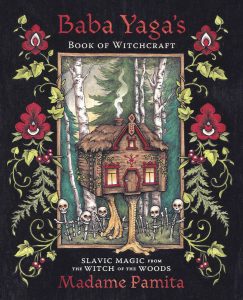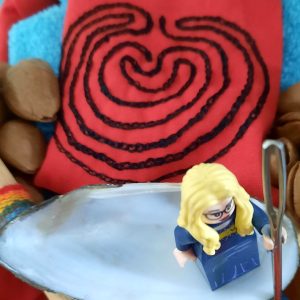Madame Pamita
Baba Yaga’s Book of Witchcraft – Slavic magic from the witch of the woods
Llewellyn 2022, ISBN-13: 9780738767895, 336 pag.
Shaping the future by exploring your roots
Can you imagine: launching a book on Slavic, Ukrainian magic, while that very country is yet again being attacked by its neighbour? Some might say ‘what is the use of a book in these hard times? It’s weapons they need to defend themselves!’ But I think it is quite powerful, especially in the long run, to give voice to a country’s culture in a book. Makes it harder to erase the identity of a country and culture, as some are trying. Energetically, I see in the current war between Russia and Ukraine how Ukraine tries to grow, to rise above past trauma and hardship, and how Russia tries to hold on to the old ways of trauma-fuelled behaviours, fears and coping mechanisms. Everybody with a traumatic past has experienced some form of these efforts to keep you in line, to protect the secrets, to stay safe within the guarded walls of the world of trauma.
Back to your roots deep into the woods
As a Ukrainian diaspora witch, it took Mme Pamita some time to rediscover her Ukrainian magical roots and to realise the witchiness of her grandmother, of any Ukrainian grandmother or baba. Her grandmother fled Ukraine to the USA and brought with her stories, habits and imageries. These were not just quirky habits (as Mme Pamita thought for a long time), but remnants of a country, a culture, and a powerful form of magic. Maybe Mme Pamita sees sharper from afar what magical gems can be found in this culture. Either way, the Ukrainian ways called her. One day, her mother and grandmother and other ancestors, including the oldest Baba Yaga, started calling and singing in her dreams:
“Remember our magic. Our ways must not be forgotten.”
Geo-politics aside, this is a very nice book, both for beginners as for more experienced witches, and also for non-Ukrainians. I for one, a Dutch-born and bred woman with quite a bit of ritual experience who loves to explore myth, magic and nature, felt inspired by Mme Pamita. She gave me new insights into some of my favourite pastimes, both mundane and magical: embroidery as protection, and spinning to fire creation. More awareness of what I already do, why I do it and what its meaning is.
For example, I realised on a deeper level the interconnectedness of the spindle and the magic wand. One could very convincingly argue, that there would be no such thing as a magic wand, without the age-old spindle and all that is done with that tool. Just look at the shape of spindles, especially the older ones: a hand-size wand or axis mundi!
Everybody who did some form of spinning experienced its miracle. You have this cloud of woolly hairs in your hand, you twist it just a little, and before you know it, a thread has formed. The pointless hairs got a purpose, and direction, just as the pointless hairs turned into fabric.
As Mme Pamita puts it: “A spindle is both a wand and a sceptre, a symbol of the power of the vidma [witch] that allows her to weave the fabric of the universe. Like the pavuk, the spider, the person who spins sits at the centre of the universe. Like Baba Yaga, spinners can create and destroy.”
Yet another beautiful example of the hermetic adage “AS ABOVE, SO BELOW”.
What I like most about this book: Mme Pamita uses her talent to weave together the broader view and context of magic with everyday activities. Magic is nothing but a theoretical exercise without a link to your mundane life. Cooking, crafting and storytelling are the embodiment of a worldview: tools to act according to that worldview and to pass it on to the next generations and/or a broader audience.
The ancestors, Baba Yaga, and mundane tools to create
The common thread throughout this book is the story of the Baba Yaga, the vilified Mistress of the Woods who lives in a house on chicken legs, surrounded by bone fences. Each chapter starts with her voice, and that of Vasylyna, the girl that wants to get to know Baba Yaga. In the chapters of this book, Baba Yaga shares her wisdom. Each chapter covers a subject such as an embroidery, dolls, crossroads, food, spindle, and many more. Magic works strongest when firmly rooted in the earth, one could almost say (as Mme Pamita actually does somewhere in the book): the mundaner the tool, the better the result.
Mme Pamita gives more context and explanation once Baba Yaga is done, and she gives easy-to-follow recipes, patterns and rituals. Without falling into the pitfall of stating what is the right or wrong way to do things, there is plenty of room for the reader to translate what is written into one’s already existing personal practice. And I can only imagine how meaningful this book might be to other Ukrainians living in the diaspora, of which there are many, due to the horrors of the Holodomor* and Second World War.
Ukrainian, Pagan, and other local ways
As someone from the Netherlands, it surprises me how much I recognize the whys and ways of this book, how much of it I can directly work with, and how much with just small adaptations. The book encourages me to explore the stories from the land I live on, and immerse myself even deeper into them than I already did.
The Ukrainian stories and the way the magic is implemented feel quite familiar. It might be me, or maybe there are more similarities throughout Europe than I would have thought. Or it is an American/Western setting of her explorations through magic and paganism, that shaped partly how Mme Pamita perceived her Ukrainian roots? I don’t say this to criticize; it is something that I often think about, without drawing firm conclusions. It seems to me that Paganism and Wicca have shaped a strong worldview and magical/ritual blueprint, that makes us in the Western world both see and interpret the stories, rituals and magical habits of our ancestors through this specific lens.
All in all, this book is a beautiful ode to the Ukrainian land, culture and stories. Written by someone born in the United States, but with firm roots in Ukraine, it offers one of the ways through which the aggression and destruction of the current war can be counterbalanced. It is a well-written invitation to explore your own personal background and roots, to shape your future in a meaningful way.
If you are interested in what she has to say, you can of course read her book, and Mme Pamita has a lively Instagram account. You can find her here: @madamepamita
— Review by Ishtar —
* Holodomor, also known as the Terror Famine, took place in 1932-33; Stalin inflicted the death of millions of Ukrainians to eliminate a Ukrainian independence movement and/or as a consequence of Soviet industrialisation and the collectivization of agriculture.



The article made me really curious. I love spinning myself and although not of Russian or Ukrainian origin myself I especially love to use the supported – so called Russian spindle. And yes, there is a lot of magic in spinning, and apart from many other aspects we’re producing the thread which may connect us all in a way.
Thank you for your reaction! Yes, the supported spindle is great.
And you put it beautifully: we produce the thread which connects us all in a way. By spinning we are adding to and shaping the fabric that is the universe.